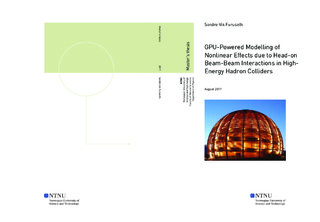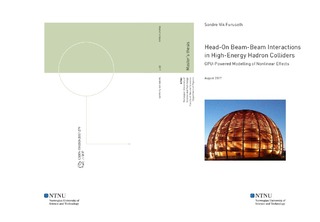| dc.description.abstract | The performance of high-energy circular hadron colliders, as the Large Hadron Collider, is limited by beam-beam interactions. The strength of the beam-beam interactions will be higher after the upgrade to the High-Luminosity Large Hadron Collider, and also in the next generation of machines, as the Future Circular Hadron Collider. The strongly nonlinear force between the two opposing beams causes diverging Hamiltonians and drives resonances, which can lead to a reduction of the lifetime of the beams. The nonlinearity makes the effect of the force difficult to study analytically, even at first order. Numerical models are therefore needed to evaluate the overall effect of different configurations of the machines.
For this thesis, a new code named CABIN (Cuda-Accelerated Beam-beam Interaction) has been developed to study the limitations caused by the impact of strong beam-beam interactions. In particular, the evolution of the beam emittance and beam intensity has been monitored to study the impact quantitatively, while frequency map analysis has been performed to understand the impact qualitatively. The bunches in the beams have been modelled based on a three-dimensional Gaussian distribution. The bunches in the Large Hadron Collider are well approximated by cylindrically symmetric Gaussian bunches, which allows for certain consequences to be derived analytically. The mapping of both round and flat beams have been implemented with the weak-strong model, considering one beam to stay fixed throughout the simulation, while the other beam is changing. The simulations have been run on graphic cards, well adapted for studying this highly parallelisable problem, to reduce the computation time.
The beam-beam driven resonances have been shown both analytically and numerically to be stronger at lower order and further from the design orbit of the beam. Stronger beam-beam interactions cause a wider spread of the betatron frequencies/tunes within a single bunch, making it increasingly difficult to avoid resonances that cause detrimental effects on the beam quality. This has been seen in both simulations and experiments. In such scenarios, the common working point in the Large Hadron Collider, (Q_x , Q_y ) = (0.31, 0.32), is found to be suboptimal. Two alternative working points, (0.315, 0.325) and (0.475, 0.485), have been found to give better performance. Without long-range interactions, the beam quality is best preserved for zero crossing angle. Increasing the crossing angle activates odd resonances that can reduce the performance further, but it also reduces the tune spread within the bunch, making the bunch exposed to fewer strong resonances. Mixing between the longitudinal and transverse planes, caused by either a crossing angle, the hourglass effect or chromaticity, drives synchro-betatron resonances that also reduce the performance. However, a nonzero chromaticity is usually necessary to avoid coherent instabilities. A significant hourglass effect, σ_s /β_q^∗ = 2/3, has been found to reduce the detrimental effects caused by the chromaticity, and vice versa. A scheme designed to cancel beam-beam driven resonances, by applying a specific intermediate phase advance, has been found to have an extremely positive impact on the beam quality for zero crossing angle, but only a marginal impact for a nonzero crossing angle. A dedicated experiment with strong head-on beam-beam interactions has been performed in the Large Hadron Collider. Simulations run in CABIN for the same configurations show good quantitative agreement. A realistic maximum beam-beam tune shift from the LHC working point has been found to be ∆Q_Tot = 0.043 with zero crossing angle. With a Piwinski angle of φ_PIW = 1, this limit is reduced to ∆Q_Tot = 0.028, smaller than the largest beam-beam tune shift expected in the Future Circular Hadron Collider. These limits are slightly larger for the alternative working point, (0.315, 0.325), raised to ∆Q_Tot = 0.067 and 0.036 for zero and nonzero crossing angle respectively. | |

